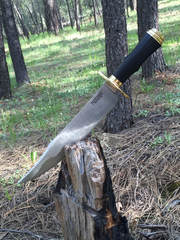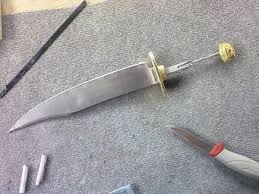
In this third installment of Battle Blades I’ll turn my attention to something of a hybrid knife, a fairly recent production bowie from the guys at Cold Steel. It’s the Natchez Bowie, and it’s everything a bowie ought to be - big, wide, and sharp.
Cold Steel named their knife the Natchez because of the history of bowie fighting in the area of Natchez, Mississippi, invoking a romantic frontier ethos for this knife. It is styled generally like the “primitive” bowie and its overall lines echo the shape of the Musso Bowie. Its blade is 11 ¾” long and 1 ¾ “ wide. It’s a big blade, fully capable of swinging, chopping, slicing . . . or even paddling, if need be.
There are four major differences between the CS Natchez and the Musso bowie. Firstly is the tip; the CS Natchez’ tip is not nearly as thin and vulnerable to lateral forces as the earlier Musso design. The tip still narrows to a needle point, but it is not upswept as on the Musso, which has the dual benefit of keeping more mass in the tip for structural rigidity, and also keeping the point in line with the wrist when the blade is extended, thus making this knife a more effective point thruster than the Musso design.
The second difference is the hilt. The CS version uses a simple and straightforward oval crossguard rather than the large “S” shaped crossguard of the Musso design. It’s really six of one, and a half dozen of another, as hilt design only comes into play when one is anticipating duelling against another blade, but it’s worth noting that CS makes a big deal of marketing this knife as a “fighting bowie” and then puts a regular utilitarian hilt on it. Things that make you go Hmmnn.
The third difference between the Natchez and Musso is in balance. The Natchez’ point of balance is just about one inch forward of the crossguard; this is still a fairly weight-forward balance, but it’s a far cry from my Musso version, which balances right at three inches forward of the crossguard! Both have a distinctly blade-heavy feel, but the Musso feels like a large, cumbersome saber, whereas the Natchez feels simply like a big knife. The weight is forward, but not overly so, and it’s still maneuverable. I like this balance point very much.
The fourth difference can’t be seen or even felt, but I know it’s there, and is the reason I called this a “hybrid” knife in my introduction. This third difference is one of construction. Cold Steel uses a full-tang construction on many knives, such as their Trail Master bowies, but their Laredo and Natchez bowies (both “fighters”) do not use full tangs. These two models use a weirdly designed cable system, in which a twisted cable attaches to a stub tang and is then tightened by a screw in the base of the grip. This provides sufficient tension to provide enough structural integrity to replace a regular tang, although its durability is not well tested so far as I know. If one listens to the legions of internet commandos, this system is a miracle of cost-cutting engineering, an overbuilt design intended to save an ounce or so of quality steel per unit. I used to own a Laredo, and have used the Natchez and not found either wanting, so perhaps this design is suitably strong. I’m something of a traditionalist, however, and knowing that my tang is really a wire cable under tension leaves me feeling a little suspect about its capabilities. In all likelihood the knife is probably completely dependable for 98+% of what real users will ask of it . . . but I’d still prefer a full tang, even if it were a lower quality steel welded onto the blade.

 RSS Feed
RSS Feed
